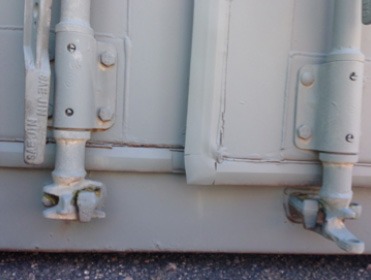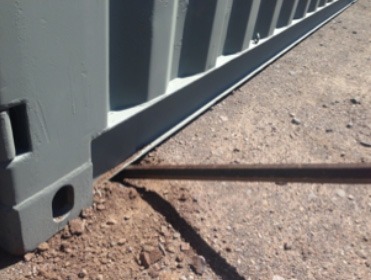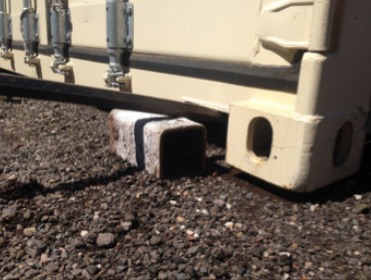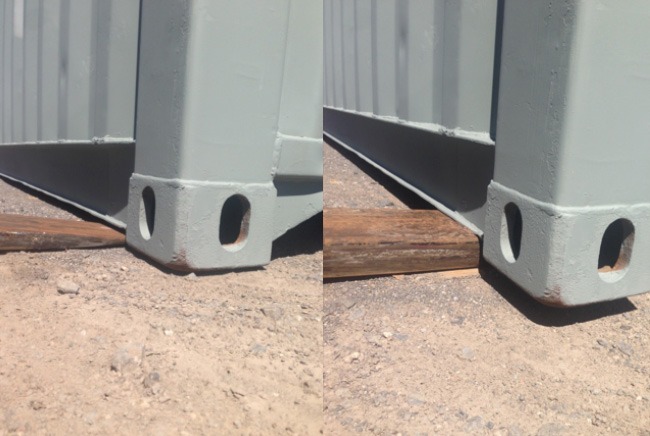This is a regular problem with shipping containers; the industry term is ‘racked’. The cause of the door/s not closing is because the container isn’t sitting flat, which is different to being ‘level’. The container can be placed on a slope & it will open & close easily as long as the surface it is sitting on is flat.
Usually what is happening is the front of the container is sloping in one direction (for example to the right) & the rear of the container is sloping in the other direction (to the left). This puts a spiral in the container and causes the door opening to twist and become diamond shaped rather than staying rectangular. As you close each door, one will close high & the other will close low.
Often this problem only presents itself once you load the container. While it is empty the structure of the container is rigid enough for it to stay in shape and not spiral/twist, often the container is that rigid it will have one corner not touching the ground. Once you place a load inside the container, this pushes the container down into the shape of the ground & forces a twist into the structure of the container and elongates the door opening.

Close both doors the best you can (left door first), them stand a few metres back from the doors and have a look at the top or bottom of the doors where they join/overlap. One door will be lower than the other; this side/corner needs to be lifted up. As it’s lifted the door opening will return to a rectangular shape & the door will fit & close properly again. If you can’t easily get to this corner to lift it, you can lift the diagonally opposite corner (opposite corner at the front wall); it will have the same effect.
The object of this fix is to lift the low corner & pack it to hold it in a higher position; containers only need to be supported in the 4 corners nowhere else – even when loaded.
There are several ways to lift the container.
If it’s on grass/dirt you could dig a small ditch/hole beside the low corner, use a strong length of timber or steel (at least 2m + in length) and place it into the hole just under the edge of the container, this will be your lever.

With one end of the lever in the hole & under the edge of the container, lift the other end high and place a block of timber/steel etc ender the lever and as close to the container as you can get it.

As you lower the lever & push down on it, it will lift the container slightly; while you hold weight down on the lever have someone place a packer/shim in the gap between the ground & the corner of the container. This gap will often only be 10mm more or less. Once the packer is in place, take the weight of the lever & lower the container back down onto the packer & try the doors & see it this was enough. If the door/s still don’t close, try this process again, lift the lever – place a bigger block under the lever & repeat the process putting in more packers until the corner comes up far enough that the container is then flat across the bottom again & the doors will close easily. Often you only need to lift this low corner 10mm to 30mm.
If the container is on cement use a large ‘crow bar’ and slide the tip under the edge of the container beside the low corner lift the end of the crow bar high in the air & place a block of timber/steel under the crow bar as close to the container as possible, then push down on the crow bar. Continue the procedure as detailed above.
If the container is too heavy for these processes, you could dig a slightly bigger hole & use a car/hydraulic jack to lift the container rather than a lever.
If you have a fork lift this is often a good solution. Even though the forklift isn’t able to lift the container you can use the tapper/wedge of the tyne to do the lifting.

Line up one fork tyne beside the low corner of the container, back up, then drive in hard under the edge of the container Because the fork tyne is tapered the tip will go under easy, and as the tyne goes further under the container, it gets thicker & acts as a wedge & lifts the container – again it will only lift if 10mm +, sometimes you can use the forward tilt on the mast to get a little more lift, the tyne acts as a lever as you tilt forward. Put in the packer and reverse the forklift out – often you’ll have to jerk the fork hard to get out from under the container. The container will now be sitting on this packer & the gap between the ground & container will now be larger. Line up the forklift again and drive it in hard, it will go in further this time & lift the container higher. Put in the packer & back the fork out, check the doors & repeat until the doors close easily.
